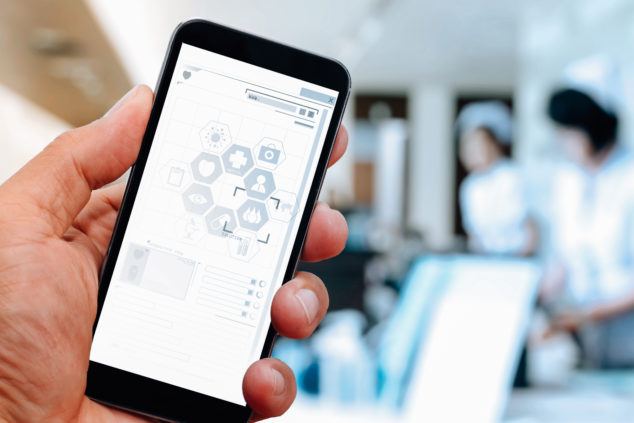Technology is continually transforming the way people work across a diverse range of industries, with the number of mobile workers predicted to climb from 1.45 billion in 2016 to 1.87 billion by 2022 – accounting for 42.5% of the global workforce. Healthcare is no exception to this, with the global healthcare mobility solutions market predicted to experience an annual growth rate of 28.3% by 2022.
The majority of organisations today already have a mobility strategy in place given the widespread nature of mobile working, and the numerous advantages it can bring.
>See also: Top 7 trends in healthcare app development
According to an EY study, over 50% of companies have deployed a strategy whereby mobile working is implemented every day. Yet the fast-paced nature of technological innovation, coupled with rapid data explosion driven by the Internet of Things (IoT), mean that such strategies constantly need to be reviewed and refreshed to meet the latest demands.
Unrelenting threats to security in healthcare
Remote working and the ever-multiplying swathes of data, which are so integral to operations today, create increasing opportunity for cybercriminals to strike. The average annual cost of such attacks on healthcare organisations is $12.87 million (£9.26 million) – the fifth most expensive of all industries, given the immense value attached to sensitive patient data.
The more data available to mine, and the more entry points there are providing access to the network, the bigger the risk. Proof of this within an increasingly data-centric healthcare sector is the 211% increase in disclosed security incidents in 2017 when compared with the previous year, according to McAfee.
>See also: How can mobile technology improve the future of healthcare?
This makes data security a major priority for healthcare IT leaders in 2018 – even more so with deadline for GDPR only a matter of weeks away – and a major part of this is ensuring mobile workers are secure, no matter where they are: 55% of European organisations plan to implement a data loss prevention initiative this year, giving rise to a number of new solutions including mobile zero clients.
Such tools help to nullify the device-level threat by withdrawing data from it, instead enabling employees to access sensitive information held more securely under central storage and management. Solutions like these, which can future-proof the IT infrastructure at a time when everything around it is moving at breakneck speed, can prove invaluable to a 2018 mobility strategy.
The edge and data proliferation
While security may be the most pressing IT and mobility-related concern for healthcare organisations right now, ensuring efficient and productive working while on the move is also becoming increasingly important.
Cloud solutions to date have served organisations well as a scalable and cost-effective method of managing sensitive patient and stakeholder data but, while the importance of the cloud won’t change, the way in which it is used may well do.
>See also: Emergency health and safety: Be smart, make it mobile
The impending arrival of 5G is set to instigate a further boom in the IoT, meaning this ongoing data rush of unprecedented levels is certain to continue and healthcare must be primed to take advantage of this. In order to relieve the strain this data will place on cloud services, a growing number of organisations are integrating an edge-focused element to their mobility infrastructure.
A report from BI Intelligence demonstrates this incline, estimating that 5.6 billion business-owned devices will be utilising edge computing for data collection and processing by 2020.
Organisations can provide an enhanced quality of service by processing data at the edge of the network, thus reducing the likelihood of data overloads while also helping mobile workers such as GPs to meet compliance regulations, for example by recording consultation notes in a timely manner.
Paving the way for wearables
As edge computing develops, so too will the solutions used to collect and manage this data. Global wearable device shipments will rise to 154 million in the enterprise by 2021, according to ABI Research, as sectors including healthcare recognise how they can utilise such technology to enhance mobile productivity.
Accenture claims that by 2020, 91% of healthcare solutions providers will include wearables in their IoT offerings to clients. This includes the adoption of long-mooted solutions such as Assisted Reality (AR) smart glasses, which can for example be used by medical workers in the field to record patient information in real-time during an examination.
>See also: Healthcare will become digitised by 2030 to keep services alive
What is clear is that, while most organisations have already embraced mobile working, whether they are executing such a strategy effectively varies from one to the next. Verizon’s Mobile Security Index 2018 found that 35% of healthcare organisations reported data loss or downtime from a mobile device security incident in the past year, while 41% admit to purposefully putting themselves at risk of a security breach for the sake of expediency or business performance.
Building, managing and maintaining a secure and agile IT strategy is more complex now than ever before, from choosing trusted devices to integrating bespoke security solutions at a network level.
It is, therefore, paramount for CIOs and CTOs to constantly assess their architecture and integrate the right solutions to ensure security, productivity and mobility in equal measure.
Sourced by Neil Bramley, B2B Client Solutions Business Unit Director, Toshiba Northern Europe










